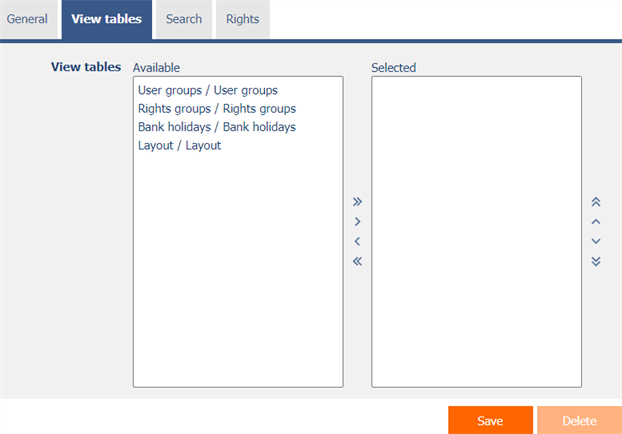Manual in PDF format
1. Basic information
1.1. Description of the control
DataSet is a multi-source lookup table that displays database records retrieved by a query from a database, with the possibility search and record filtering.
1.2. Create a new control
A new dataset can be created as follows from the view page using the toolbar with controls:
- First, clicking the mouse on the view page determines the position in which the new dataset should be placed. This will highlight the selected position with a gray horizontal line. Then just click on the “DataSet” item in the toolbar of the view page, fill in the attributes of the new control in the newly opened dialog, and then save. This will insert a new dataset at a pre-selected location on the view page.
- If the desired position is not determined before inserting a new dataset, the new dataset will be inserted at the end of the view page.
1.3. Edit or delete a control
- For each existing control, a pencil icon appears to the left of the control page to change or delete the control's settings.
- Individual controls can be moved vertically on the view page using the Drag&Drop method. Moving consists of grabbing the control, preferably behind its name, and then dragging it to the desired location on the view page.
- For security reasons, it is important to have the function of moving controls enabled using the “Drag&Drop” check box located above the toolbar with controls. This field is unchecked each time you log in to the application.
2. List of tabs in the control settings dialog
- General – Setting general properties
- View tables – Lookup table column settings
- Search – Search settings
- Rights – Rights settings
- Administration – Setting other properties
2.1. “General” tab

2.1.1. Name
- The name of the control displayed in the header of the lookup table.
2.1.2. Dictionary
- The dictionary lists the names of other controls, forms, view pages, categories, applications, and application groups used across the entire application.
- The dictionary search is used to design the correct control name and to maintain the consistency of the nomenclature throughout the application so that controls with the same meaning located in different places in the application are named in the same way.
2.1.3. Width
- The width of the control, expressed in pixels.
- If this input field is not filled in, the width of the look-up table will be determined automatically by the web browser.
2.1.4. Options
- Allow multiple assignments
- Checking this box determines whether a text box or drop-down list with the selected value should be displayed in the lookup table instead of the control value itself, with the option to change the value without opening and editing the record in the edit form.
- This function is applied only to controls that have the “Allow bulk changes” check box selected on the “General” tab.
- Bulk changes can only be made by a logged-in user, a text box or a read-only drop-down list is displayed to an anonymous user.
- Checking this box determines whether the “Assign value…” item should be available in the filter drop-down list of individual columns, which is used to assign a value to all filtered records in the lookup table.
- This function is applied only to controls that have the “Allow bulk changes” check box selected on the “Filters” tab.
- Bulk changes can only be made by a logged-in user.
- Checking this box determines whether a text box or drop-down list with the selected value should be displayed in the lookup table instead of the control value itself, with the option to change the value without opening and editing the record in the edit form.
2.2. “View tables” tab

- Definition of a list of lookup tables that will be merged into one within the dataset.
2.3. Search tab

2.3.1. Options
- Activate search
- Checking this box determines whether a row with a search box and a “Search” button should be automatically displayed in the header of the lookup table.
2.4. “Rights” tab

2.4.1. Rights
- Rights define a list of user groups and users who have permission to display the control on the view page.
2.4.2. Replace rights to other controls
- The “Replace rights to other controls” feature is used to unify rights across the entire view page for controls that are related in terms of rights.
- Thanks to the “Show…” link, it is possible to display a list of all controls on the view page, including the settings of the rights of these controls. For each control, a check box is displayed that allows you to select the control. When you save a control, the same rights are then set for those selected controls.
- An alternative for unifying rights within the entire view page is to display the report available from the “Subordinate object rights” tab in the view page settings.
2.5. “Administration” tab

- The “Administration” tab is only displayed for existing controls.
2.5.1. Location
- Select the view page on which the control is located.
- The drop-down list contains all view pages located in the same application.
